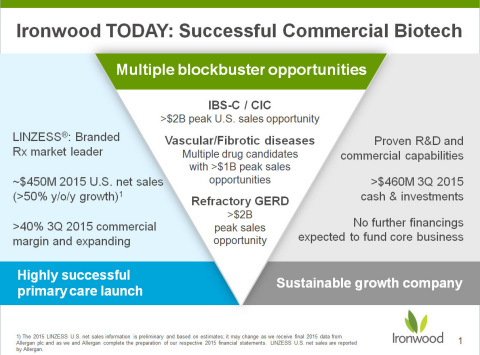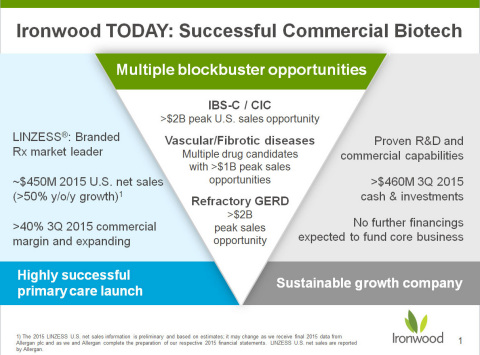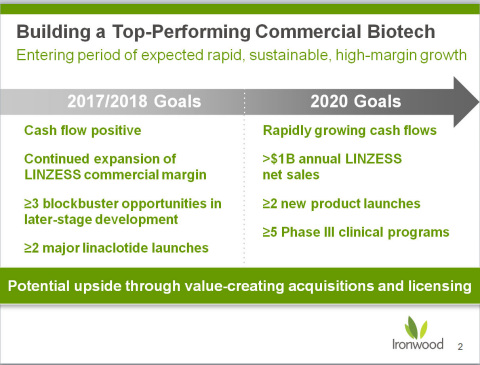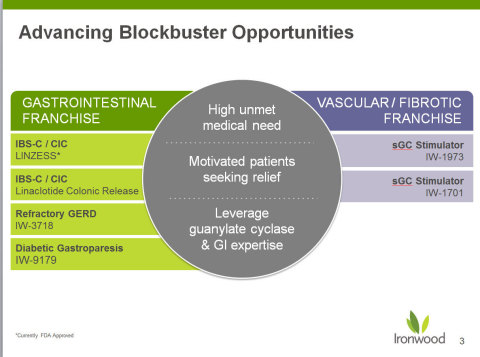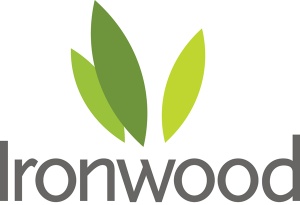CAMBRIDGE, Mass.--(BUSINESS WIRE)--Ironwood Pharmaceuticals, Inc. (NASDAQ:IRWD) today detailed its strategy to build a top-performing commercial biotechnology company generating rapid, sustainable, high-margin growth. As part of this strategy, the Company outlined three- and five-year operational and financial goals, which include bringing new medicines to market, advancing several blockbuster opportunities into later-stage clinical development, and generating growing cash flows. These goals do not include the potential upside impact of any acquisitions, licensing or other corporate development transactions.
“Ironwood is one of the few companies in the biopharmaceutical industry to have successfully discovered, developed and commercialized a product that has become the branded prescription market leader in its category,” said Peter Hecht, chief executive officer of Ironwood. “Our flagship product LINZESS is well on its way to becoming our first blockbuster: in just its third year on the market, it generated approximately $450 million in 2015 U.S. net sales, annual growth of more than 50%, and is delivering rapidly expanding commercial margins. We are advancing potential blockbuster products for IBS-C/CIC, vascular/fibrotic diseases, and refractory GERD, and we believe the growing contribution from our commercial business and cash on hand are sufficient to fully fund our core business without the need to raise additional capital.”
2015 Accomplishments and Updates:
- Ironwood is advancing internally-developed programs in at least three important franchises: irritable bowel syndrome with constipation (IBS-C)/chronic idiopathic constipation (CIC), where LINZESS and linaclotide colonic release may represent a peak U.S. sales opportunity exceeding $2 billion (shared 50/50 with Allergan plc), with additional global potential; vascular and fibrotic disease, where multiple sGC stimulators may each represent a peak sales opportunity exceeding $1 billion; and refractory gastroesophageal reflux disease (GERD), where IW-3718 may represent a peak sales opportunity exceeding $2 billion.
- LINZESS U.S. net sales, based on estimates provided by Allergan, are expected to be approximately $450 million for the full year 2015, an increase of more than 50% compared to the full year 2014. LINZESS U.S. net sales are reported by Allergan, and final numbers will be provided during Ironwood’s Fourth Quarter 2015 Investor Update.
- Nearly 1 million unique patients have filled a LINZESS prescription since its launch in December 2012, according to IMS Health.
2017/2018 Operational and Financial Goals:
- Ironwood expects its current business to become cash flow positive during this period.
- At least three clinical programs targeting major opportunities are expected to be in later-stage clinical development by the end of 2018. These may include linaclotide colonic release for the treatment of IBS-C, IW-3718 for the treatment of refractory GERD, at least one sGC stimulator in an indication to be determined based on early-stage clinical data, a second formulation of linaclotide colonic release intended for the treatment of IBS-mixed and IW-9179 for the treatment of diabetic gastroparesis.
- At least two additional linaclotide launches are anticipated by the end of 2018, beginning with the 72 mcg dose of linaclotide in the U.S. in the first half of 2017.
By the end of 2020, Ironwood expects:
- To be generating rapidly growing cash flows.
- LINZESS annual net sales to be at least $1 billion.
- At least two additional product launches from Ironwood’s internal pipeline.
- At least five Phase III clinical programs ongoing.
“Ironwood’s proven expertise in R&D innovation, commercial performance and strategic partnering, performed by an incredibly talented team committed to financial discipline, have allowed us to build the bedrock of a successful commercial biotechnology company,” said Hecht. “We created a treatment for a significant unmet medical need in which patients are motivated to seek relief, and we are now pushing hard to repeat this success with the product candidates in our pipeline as we work to deliver on our commitment to sustainable, high-margin growth as one of the industry’s top-performing commercial biotechnology companies.”
Ironwood will provide further details on this strategy during its presentation at the 34th Annual J.P. Morgan Healthcare Conference on Monday, January 11, 2016 at 1:30 p.m. Pacific Time / 4:30 p.m. Eastern Time at the Westin St. Francis Hotel in San Francisco. The presentation will be followed by a question and answer session that will begin at 2:00 p.m. Pacific Time / 5:00 p.m. Eastern Time.
A live webcast of Ironwood’s presentation and the question and answer session will be accessible through the Investors section of the company’s website at www.ironwoodpharma.com. To access the webcast, please log on to the Ironwood website approximately 15 minutes prior to the start time to ensure adequate time for any software downloads that may be required. A replay of the webcast will be available on Ironwood’s website for 14 days following the conference.
About Linaclotide Colonic Release
Results derived from responses to a web based survey commissioned by Forest Pharmaceuticals and Ironwood Pharmaceuticals suggest that up to 40 million adults in the U.S. may suffer from irritable bowel syndrome with constipation (IBS-C) or chronic idiopathic constipation (CIC). Linaclotide is indicated for the treatment of these conditions in adults and is the first and only FDA-approved guanylate cyclase‐C (GC‐C) agonist. It binds to the GC-C receptor in the intestine and is thought to work in two ways, based on non-clinical studies: by decreasing the activity of pain-sensing nerves and by increasing fluid secretion into the intestine. The investigational linaclotide colonic release formulations are second generation GC-C agonists designed to provide targeted delivery of linaclotide to the distal small intestine and colon. This may further decrease the activity of key pain-sensing nerves in the colon with a smaller increase in fluid secretion. Ironwood believes a linaclotide colonic relief formulation designed to improve abdominal pain relief could offer the opportunity to drive growth and expand the IBS-C/CIC market.
About Ironwood’s sGC Platform
Dysregulation of the enzyme soluble guanylate cyclase (sGC) may play a role in multiple vascular and fibrotic diseases with high unmet need such as pulmonary arterial hypertension, congestive heart failure, Duchenne muscular dystrophy, diabetic nephropathy, achalasia, and other disorders. Found throughout the body, sGC is part of a signaling pathway that regulates blood flow, inflammation and fibrosis and, its impairment can lead to end organ failure and death. Ironwood established its expertise in this signaling pathway through the discovery and development of linaclotide, a guanylate cyclase C (GC-C) agonist. Stimulation of sGC is a clinically validated approach, and Ironwood leveraged its GC-C expertise to discover a broad library of sGC stimulators. Ironwood’s investigational sGC stimulators IW-1973 and IW-1701 have demonstrated high tissue penetration in non-clinical models and are in Phase I studies with data expected in 2016.
About IW-3718 and Refractory Gastroesophageal Reflux Disease (GERD)
Greater than 45 million Americans are estimated to suffer from refractory gastroesophageal reflux disease (GERD), and of those an estimated 10 million experience continued symptoms such as heartburn and regurgitation despite receiving the current standard of care treatment with a proton pump inhibitor (PPI) to suppress stomach acid production. There are a limited number of FDA-approved treatment options for these patients. Research suggests reflux of bile from the intestine into the stomach and esophagus may play a role in the ongoing symptoms of refractory GERD patients. IW-3718 is a novel, gastric retentive formulation of a bile acid sequestrant designed to reduce bile exposure in the esophagus. Data from an exploratory Phase IIa clinical study indicated IW-3718 improved heartburn and certain other symptoms associated with refractory GERD, and a Phase IIb trial is expected to initiate in early 2016.
About LINZESS® (linaclotide)
LINZESS is the first and only guanylate cyclase-C (GC-C) agonist approved by the FDA and is indicated for the treatment of both irritable bowel syndrome with constipation (IBS-C) and chronic idiopathic constipation (CIC) in adults. LINZESS is a once-daily capsule that helps relieve the abdominal pain and constipation associated with IBS-C, as well as the constipation, infrequent stools, hard stools and incomplete evacuation associated with CIC. The recommended dose is 290 mcg for IBS-C patients and 145 mcg for CIC patients. LINZESS should be taken at least 30 minutes before the first meal of the day.
LINZESS is thought to work in two ways based on nonclinical studies. LINZESS binds to the GC-C receptor locally, within the intestinal epithelium. Activation of GC-C results in increased intestinal fluid secretion and accelerated transit and a decrease in the activity of pain-sensing nerves in the intestine. The clinical relevance of the effect on pain fibers, which is based on nonclinical studies, has not been established.
In placebo-controlled Phase III clinical trials of more than 2,800 adults, LINZESS was shown to reduce abdominal pain in IBS-C patients and increase bowel movement frequency in both IBS-C patients and CIC patients. Improvement in abdominal pain and constipation occurred in the first week of treatment and was maintained throughout the 12-week treatment period. Maximum effect on abdominal pain was seen at weeks 6-9 and maximum effect on constipation occurred during the first week. When a subset of LINZESS-treated patients in the trials were switched to placebo, they reported their symptoms returned toward pretreatment levels within one week, while placebo-treated patients switched to LINZESS reported symptom improvements. LINZESS is contraindicated in pediatric patients under 6 years of age. The use of LINZESS in pediatric patients 6 through 17 years of age should be avoided. In nonclinical studies, administration of a single, clinically relevant adult oral dose of linaclotide caused deaths due to dehydration in young juvenile mice. The safety and efficacy of LINZESS in pediatric patients under 18 years of age have not been established. In adults with IBS-C or CIC treated with LINZESS, the most commonly reported adverse event was diarrhea.
Ironwood and Allergan plc are co-promoting LINZESS in the United States. Linaclotide is marketed by Allergan for the treatment of adults with moderate to severe IBS-C in Europe under the brand name CONSTELLA®. Ironwood also has partnered with Astellas Pharma Inc. for development and commercialization of linaclotide in Japan and with AstraZeneca for development and commercialization in China.
LINZESS Important Safety Information
|
WARNING: PEDIATRIC RISK |
|
LINZESS is contraindicated in pediatric patients under 6 years of age. In nonclinical studies, administration of a single, clinically relevant adult oral dose of linaclotide caused deaths due to dehydration in young juvenile mice. Use of LINZESS should be avoided in pediatric patients 6 through 17 years of age. The safety and efficacy of LINZESS has not been established in pediatric patients under 18 years of age. |
Contraindications
- LINZESS is contraindicated in pediatric patients under 6 years of age.
- LINZESS is contraindicated in patients with known or suspected mechanical gastrointestinal obstruction.
Warnings and Precautions
Pediatric Risk
- LINZESS is contraindicated in children under 6 years of age. The safety and effectiveness of LINZESS in pediatric patients under 18 years of age have not been established. In neonatal mice, increased fluid secretion as a consequence of GC-C agonism resulted in mortality within the first 24 hours due to dehydration. Due to increased intestinal expression of GC-C, children under 6 years of age may be more likely than older children and adults to develop significant diarrhea and its potentially serious consequences.
- Use of LINZESS should be avoided in pediatric patients 6 through 17 years of age. Although there were no deaths in older juvenile mice, given the deaths in young juvenile mice and the lack of clinical safety and efficacy data in pediatric patients, use of LINZESS should be avoided in pediatric patients 6 through 17 years of age.
Diarrhea
- Diarrhea was the most common adverse reaction of LINZESS-treated patients in the pooled IBS-C and CIC double-blind placebo-controlled trials. Severe diarrhea was reported in 2% of LINZESS-treated patients. The incidence of diarrhea was similar in the IBS-C and CIC populations.
- Patients should be instructed to stop LINZESS if severe diarrhea occurs and to contact their healthcare provider. The healthcare provider should consider dose suspension and rehydration.
Adverse Reactions
- In IBS-C clinical trials, the most common adverse reactions in LINZESS-treated patients (incidence ≥2% and greater than placebo) were diarrhea (20% vs 3% placebo), abdominal pain (7% vs 5%), flatulence (4% vs 2%), headache (4% vs 3%), viral gastroenteritis (3% vs 1%) and abdominal distension (2% vs 1%).
- In CIC clinical trials, the most common adverse reactions in LINZESS-treated patients (incidence ≥2% and greater than placebo) were diarrhea (16% vs 5% placebo), abdominal pain (7% vs 6%), flatulence (6% vs 5%), upper respiratory tract infection (5% vs 4%), sinusitis (3% vs 2%) and abdominal distension (3% vs 2%).
Please see full Prescribing Information including Boxed Warning: http://www.frx.com/pi/linzess_pi.pdf.
About Ironwood Pharmaceuticals
Ironwood Pharmaceuticals (NASDAQ: IRWD) is focused on creating medicines that make a difference for patients, building value to earn the continued support of our fellow shareholders, and empowering our team to passionately pursue excellence. We discovered, developed and are commercializing linaclotide, which is approved in the United States and a number of other countries. Our pipeline priorities include exploring further opportunities for linaclotide, as well as leveraging our therapeutic expertise in gastrointestinal disorders and our pharmacologic expertise in guanylate cyclases to address patient needs. Ironwood was founded in 1998 and is headquartered in Cambridge, Mass. Connect with us at www.ironwoodpharma.com or on Twitter at www.twitter.com/ironwoodpharma; information that may be important to investors will be routinely posted in both these locations.
LINZESS and CONSTELLA are trademarks owned by Ironwood Pharmaceuticals, Inc. Any other trademarks referred to in this press release are the property of their respective owners. All rights reserved.
This press release contains forward-looking statements. Investors are cautioned not to place undue reliance on these forward-looking statements, including, but not limited to, statements about development, launch and commercialization plans for linaclotide and our product candidates and our corporate goals; commercial efforts for linaclotide and the other products that we promote and the drivers, timing, impact and results thereof; market size, growth and opportunity, including peak sales, and potential demand for linaclotide, our product candidates and the other products that we promote, as well as their potential impact on applicable markets; the potential indications for, and benefits of, linaclotide and our product candidates; the anticipated timing of pre-clinical, clinical and regulatory developments; the design, timing and results of clinical and preclinical studies; the timing of filings with regulatory authorities; expected periods of patent exclusivity; the strength of the intellectual property protection for our product and product candidates; potential business development activity and the timing and impact thereof; profitability of the U.S. LINZESS brand collaboration with Allergan plc; and our company's financial performance and results, and guidance and expectations related thereto, including our projected cash needs and expectations regarding the need for future financings, cash flows, operating expenses, revenue growth, operating leverage, commercial margin, and LINZESS net sales and marketing and sales expense. Each forward‐looking statement is subject to risks and uncertainties that could cause actual results to differ materially from those expressed or implied in such statement. Applicable risks and uncertainties include, but are not limited to, those related to pre-clinical and clinical development, manufacturing, and formulation development; the risk that findings from our completed nonclinical and clinical studies may not be replicated in later studies; decisions made by U.S. regulatory authorities, the U.S. Patent and Trademark Office and their foreign counterparts; the risk that we may never get sufficient patent protection for linaclotide and our product candidates; intellectual property rights of competitors or potential competitors; efficacy, safety and tolerability of linaclotide and our product candidates; competition in disease states; the commercial potential of linaclotide, our product candidates and the other products that we promote; the risk that our planned investments do not have the anticipated effect on our company revenues, linaclotide or our product candidates; the risk that we are unable to identify and execute on business development opportunities in a cost-effective and timely manner or that such opportunities do not have the impact expected; the risk that we are unable to manage our operating expenses and capital expenditures due to foreseeable or unforeseeable events or occurrences; and the risk that we and Allergan are unable to commercialize LINZESS effectively or within the guided range of expenses. Applicable risks also include those that are listed under the heading "Risk Factors" and elsewhere in Ironwood's Quarterly Report on Form 10-Q for the quarter ended September 30, 2015, in addition to the risk factors that are listed from time to time in Ironwood's Annual Reports on Form 10‐K, Quarterly Reports on Form 10‐Q and any other subsequent SEC filings. Ironwood undertakes no obligation to update these forward-looking statements to reflect events or circumstances occurring after this press release. Except as otherwise noted, these forward-looking statements speak only as of the date of this press release. All forward‐looking statements are qualified in their entirety by this cautionary statement. Further, the 2015 LINZESS U.S. net sales information included in this press release is preliminary and based on estimates; it may change as we receive final 2015 data from Allergan and as we and Allergan complete the preparation of our respective 2015 financial statements. LINZESS U.S. net sales are reported by Allergan.

